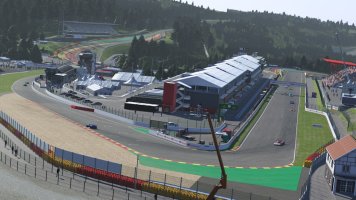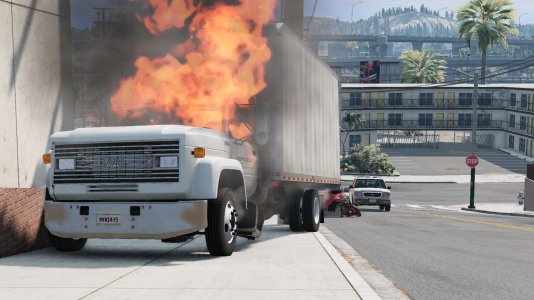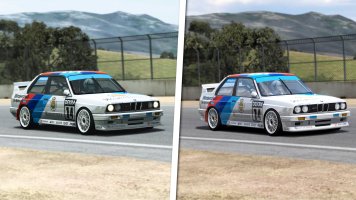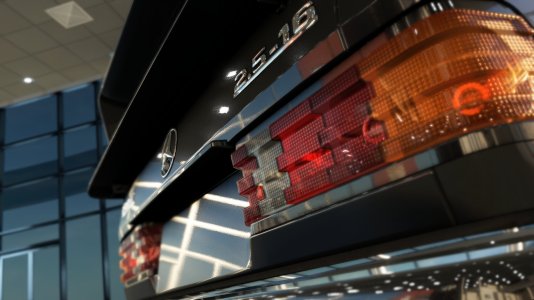don't give CSP guys more ideas than they currently haveno ability to fiddle with carbs for first half of hour after the session start, to get the car barely running and get rid of misfire, just to realize you drained all the battery in the process
You are using an out of date browser. It may not display this or other websites correctly.
You should upgrade or use an alternative browser.
You should upgrade or use an alternative browser.
The "What Are You Working On?" Thread
- Thread starter garyjpaterson
- Start date
1. Single point tyre contact patch. Older cars slid more and used more of the tire than modern cars, such as when it flexed under load and changed the shape of the tire. There are also other limitations regarding pre-war tyre simulation, such as difficulties simulating solid rubber on a wood rim.Besides not supporting all of the suspension types of the period, what do you mean by this?
2. Suspension limitations, as you mentioned.
3. Engine & drivetrain performance can get really odd in my experience when dealing with 1886, 1906, & 1907 figures. For example, the game engine doesn't really work realistically regarding 1/2 hp car engines.
4. The really low RPM of engines can also lead to other issues. For example creating sounds for those cars is an interesting experience.
I didn't mean to indicate that Assetto Corsa isn't a solid game engine for vintage or classic cars, and it's probably the best choice. It just certainty wasn't designed with 1886-1916 cars in mind. And even with 1919-1941 cars there are limitations.
Last edited:
1. Doesn't really matter, the behavior will still be defined by the same things that are in the AC tire model. Same thing with solid rubber really, you just have to parametrize them a lot differently than you would for a "normal" tire. Doesn't make the engine any less adept at simulating the tires, you just need to use it correctly. Wood rims are interesting, but even modern racing rims flex to the tune of 1 degree of camber under load, which no public simulator models, so neither here nor there really.1. Single point tyre contact patch. Older cars slid more and used more of the tire than modern cars, such as when it flexed under load and changed the shape of the tire. There are also other limitations regarding pre-war tyre simulation, such as difficulties simulating solid rubber on a wood rim.
2. Suspension limitations, as you mentioned.
3. Engine & drivetrain performance can get really odd in my experience when dealing with 1886, 1906, & 1907 figures. For example, the game engine doesn't really work realistically regarding 1/2 hp car engines.
4. The really low RPM of engines can also lead to other issues. For example creating sounds for those cars is an interesting experience.
I didn't mean to indicate that Assetto Corsa isn't a solid game engine for vintage or classic cars, and it's probably the best choice. It just certainty wasn't designed with 1886-1916 cars in mind. And even with 1919-1941 cars there are limitations.
3. Have to make sure the values you're putting in all go together. Can't e.g. have the inertia or engine braking of a v12 for a 1/2hp engine. Once you align everything, the behavior will be representative. There are drivable fruits on this site; no big limitations.
4. Not really an issue though? Same sort of situation as #1, the engine handles it fine, you just have to set it up for it.
I think we have some really good approximations of the Cars - even if they're not 100% accurate 'under the Hood', the Driving experience is still quite believable. I doubt most of us could feel if the Rear Axle of the W125 would be more accurately reproduced. That bloody thing still would want to kill me as soon as I touch the Pedal, anyway
Last edited:
If we're talking vintage cars, and the "feel" aspect of it, I can't get enough exciting experience with them in AC for some reason. I've driven various classic cars, and own one, and to me most of vintage/classic cars feel like modern car on crappy tires. Like, the suspension, steering is very tight, modern-alike, and that is compensated with tyres that lack any bite, and you are just hovering around. Very few cars I'm pleased with, mostly Pessio's Alfa GTA and Carpi, but still can't get past that uncanny feeling of something perceived wrong thru my settings. Maybe it's the headphysics, maybe the ffb, but can't point my finger on what exactly is going on, or not going on. To bizarrely summarize, they feel too "clean" or "sterile" to me. Any advices, or any suggestion of good recreation of 60's or 70's car to AC standards? Sorry for derailing the thread in that direction
Last edited:
@KittX have you tried Stereo's Porsche 912? Races very well with Kunos' Alfa GTA? Pessio and Abbo90's 'Mustard' and 'Scorpion' are also excellent IMO, as is the TVR Griffith. Plenty of others around too; Alfa Giulietta Spyder is probably more of a handful than the real thing.
What do you think of Kunos' Escort or Porsche 718, for example?
What do you think of Kunos' Escort or Porsche 718, for example?
By the way, id happily continue the discussion to a separate topic if it comes too long and bothersome.@KittX have you tried Stereo's Porsche 912? Races very well with Kunos' Alfa GTA? Pessio and Abbo90's 'Mustard' and 'Scorpion' are also excellent IMO, as is the TVR Griffith. Plenty of others around too; Alfa Giulietta Spyder is probably more of a handful than the real thing.
What do you think of Kunos' Escort or Porsche 718, for example?
Haven't got my hands on Mustard yet, the Capri and Alfa GTAm drive closer to what i'd expect. Kunos' escort... is a fun car, but it drives more like volvo 740 with drift wishbone kit attached to it - it has a lot of weight and inertia, slides a lot, and has a lot of angle to play with... Yet what i'd expect from cossie escort, is more snappy, point and shoot behaviour, with more bite on corner entry, body more hopping around. And that's general theme with many vintage cars, the TVR you mentioned, or Pessio's Pantera, they are great cars for having fun and sliding around, but somehow they are missing the "raw" feel of grip in the tires when they (still) have grip, and while there is some bodyroll, it's very firm and subtle, like in modern cars, not that random-ish and sloppy, especially in the cars that use panhard rod. Generally i came from GPL, then GTL and Historx, and somehow while Historx had some handling weirdnesses, the perception of being in classic car was reflected there the best imo, but that easily can be because my wheel settings or headphysics, or whatever else, sensivity/linearity, has aligned that way that it clicked for me. I have no issues with modern cars in AC though.
Offtopic#2: since we talk Escort, i remember someone was making one without front splitter. It wasn't released in the end i guess?
Last edited:
I think AC's tire model needs a lot of work. One contact point is just inaccurate no matter how good you code it. And it's a problem that especially reveals itself in older cars. The good news is that it is something I'm sure AC2 will fix.1. Doesn't really matter, the behavior will still be defined by the same things that are in the AC tire model. Same thing with solid rubber really, you just have to parametrize them a lot differently than you would for a "normal" tire. Doesn't make the engine any less adept at simulating the tires, you just need to use it correctly. Wood rims are interesting, but even modern racing rims flex to the tune of 1 degree of camber under load, which no public simulator models, so neither here nor there really.
3. Have to make sure the values you're putting in all go together. Can't e.g. have the inertia or engine braking of a v12 for a 1/2hp engine. Once you align everything, the behavior will be representative. There are drivable fruits on this site; no big limitations.
4. Not really an issue though? Same sort of situation as #1, the engine handles it fine, you just have to set it up for it.
I agree to a point. And of course I've adjusted all engine values to reflect the actual specifications, but the behavior can still get weird. That's why I've said then it becomes a game of deviating away from actual specs to produce a more authentic result. Even if the background numbers aren't perfectly representative of historical data.
Well, it could be my lack of experience. But it definitely seems impossible to get reasonable and realistic variations in sound across a range within one or two RPM. Which is important when the car only revs to 250 peak RPM.
In the end though, clearly we both agree that certain aspects of the game engine are not great from the perspective of creating vintage cars. Yet we both still love Assetto Corsa.
Last edited:
The single contact point model is currently being used for a high level, very well correlated LMP2 program (among others) without issue....it is a very minor factor in the accuracy of the tire model. There are other things in the vanilla AC model that are lacking, but the single contact point is far from the most important. Even ACC technically still uses a single point model (all of the fluff they've written about a multi point model is just obscuring that it's 5 ray casts feeding the single contact model a better normalized contact vector, the model itself is still just using a single point).I think AC's tire model needs a lot of work. One contact point is just inaccurate no matter how good you code it. Something I'm sure AC2 will fix.
I'm going to suggest that some of your values are still not right. There's nothing in the AC code to make lower powered or lower mass cars work less effectively, and it's all stored in float (or higher) precision. At the end of the day, it's just a solver, it doesn't care how small the numbers are as long as it has the precision to deal with them. I'd be careful with placing blame on a robust physics engine (the underlying solver is ODE) instead of personal inexperience.I agree to a point. And of course I've adjusted all engine values to reflect the actual specifications, but the behavior can still get weird. That's why I've said then it becomes a game of deviating away from actual specs to produce a more authentic result. Even if the background numbers aren't perfectly representative of historical data.
This is more of a test vehicle than a good recreation for a couple of reasons, but, if it works for you, you can have loose steering...Like, the suspension, steering is very tight, modern-alike, and that is compensated with tyres that lack any bite, and you are just hovering around. Any advices, or any suggestion of good recreation of 60's or 70's car to AC standards? Sorry for derailing the thread in that direction
Why I say "if it works" is, it's using an undocumented feature of CSP, it definitely doesn't work for AIs, and is intermittent at best for players, and can cause crashes if it's not working well. (to be clear: only when selecting this vehicle in the menu and trying to drive it. doesn't affect other installed cars)
http://90d.ca/d/ford_f150_flea_v2.7z (right click, save link...)
Due to above problems I haven't given it the usual final polish & not uploaded to RD. There's no real tech support, it seems to work on some installs but not others and I've gone all up and down CSP settings without finding a fix.
Last I heard it's more likely to crash with the increased precision part of the patch that makes 15+km wide tracks work better, only soft lock requiring a restart otherwise. I haven't really been keeping up with csp development so I don't have a specific version recommendation other than as recent as possible.
Anyway it's a 1979 F150 with front solid axle, it's still technically all rigid links as usual with AC, but since the steering box is on the chassis and links down to the axle, the entire axle can move laterally to cancel out steering inputs (which is for the best, with this design bumpsteer is unavoidable and fairly major)... it may not be too noticeable on a wide racetrack but if you try to go the speed limit on High Force or something it's fairly difficult.
Kyuubeey
@Simberia
You must know by now that you made an uninformed statement, but I'm going to feed the fire; why is it inherently inaccurate?I think AC's tire model needs a lot of work. One contact point is just inaccurate no matter how good you code it. And it's a problem that especially reveals itself in older cars. The good news is that it is something I'm sure AC2 will fix.
Issues with Assetto Corsa's tire model:You must know by now that you made an uninformed statement, but I'm going to feed the fire; why is it inherently inaccurate?
1) The tyres can explode, but the game engine has issues simulating delamination, going flat, punctures, damage to the tire's sidewall from contact with a wall or another car, etc. These issues with tyres occurred much more commonly in racing back in day, and the cars we are modeling sure are historical artifacts.
2) Single contact point of the tyre results in unrealistic simulation. For example, a tyre will at some point go off the edge of the pavement, over a curb, or sharp bump of some sort; when that happens with a single contact point the tyre will go from nothing, nothing... boom instantly everything... nothing again. Unlike in reality, and many other sims, where the edge of a tyre will contact the bump and go up, angling the tyre but not raising the tyre all in one instance. A single contact point creates a much more unstable and unrealistic physics engine and overall driving experience. This is magnified with vintage cars, which if you are going to be driving them on period correct tracks there will be more bumps and roughness. Which, as I explained, a single point of contact will struggle with. However, instability isn't even the end of the issues with a single contact point. Contacting a curb for example with a single contact point tyre will result in a big spikes in load and rolling resistance, alter traction and mechanical grip in an unrealistic way, and it will affect a locked differential as well driving more torque into the outside rear tyre. Thus a single contact point tyre affects the entire feel and handling of a car, and it is even more pronounced with vintage cars.
3. Limited flex of tyres. There is tyre flex, but not in all dimensions (only laterally and vertically). Though the simplicity of coding tyre flex in AC is nice from a programmer's point of view, it is clearly not perfectly accurate and that is one reason why Assetto Corsa Competizione has tyre flex in 3 dimensions in order to help increase realism. Other sims have 3d tyre models which would even more accurately model flex. Tyre flex is a huge deal in older cars.
4. Lack of flex in wheel rims. IER stated that no public simulator simulates wheel rim flex, which I believe is true, and ultimately it doesn't really matter that much for modern cars. However, I have been researching about how wooden wheels would flex, take damage, splinter and disintegrate, etc. Wooden wheel rimmed cars drive very differently then cars with metal wheels. I am sorry, but it is just impossible to perfectly recreate the experience and feel of driving a 1906 Itala without that modeled in the game engine. Further, even the wheels on cars in the 1930s and 1950s have different characteristics then modern cars. Hopefully AC2 will remedy this large gap in physics engines, so then my studio could update our Dawn of Speed pack for AC2 with even more accurate handling and physics.
Now this is not to say that these issues cannot be mitigated through other lines of code in the physics. Clearly they can. As the director of mod creation at Casual Sim Studios it is my job to ensure that we are overcoming these issues as best as possible in order to deliver an authentic historic simulation racing experience. As mentioned in an earlier post, our goal is to strive for an authentic feel over perfect statistical accuracy, because we recognize the limitation of certain aspects of the Assetto Corsa game engine.
I brought this up originally not to hate on a nearly decade old game engine, but rather to explain why CSS is taking this specific approach to designing the physics of our cars for AC. IER wished to discuss this in further detail, and I have obliged. However, if IER would like to continue this conversation, for the sake of everyone on this forum, I'd ask that they direct message me and we can continue our very nerdy conversation. Cheers.
Kyuubeey
@Simberia
None of that answered why a single point tire model is inherently inaccurate. If you would like to express in a mathematical format why the inherent behavior of the model ie: slip, load, flex etc. is flawed in a single point model, and why adding more points would make it less flawed, I'm all ears.Issues with Assetto Corsa's tire model:
1) The tyres can explode, but the game engine has issues simulating delamination, going flat, punctures, damage to the tire's sidewall from contact with a wall or another car, etc. These issues with tyres occurred much more commonly in racing back in day, and the cars we are modeling sure are historical artifacts.
2) Single contact point of the tyre results in unrealistic simulation. For example, a tyre will at some point go off the edge of the pavement, over a curb, or sharp bump of some sort; when that happens with a single contact point the tyre will go from nothing, nothing... boom instantly everything... nothing again. Unlike in reality, and many other sims, where the edge of a tyre will contact the bump and go up, angling the tyre but not raising the tyre all in one instance. A single contact point creates a much more unstable and unrealistic physics engine and overall driving experience. This is magnified with vintage cars, which if you are going to be driving them on period correct tracks there will be more bumps and roughness. Which, as I explained, a single point of contact will struggle with. However, instability isn't even the end of the issues with a single contact point. Contacting a curb for example with a single contact point tyre will result in a big spikes in load and rolling resistance, alter traction and mechanical grip in an unrealistic way, and it will affect a locked differential as well driving more torque into the outside rear tyre. Thus a single contact point tyre affects the entire feel and handling of a car, and it is even more pronounced with vintage cars.
3. Limited flex of tyres. There is tyre flex, but not in all dimensions (only laterally and vertically). Though the simplicity of coding tyre flex in AC is nice from a programmer's point of view, it is clearly not perfectly accurate and that is one reason why Assetto Corsa Competizione has tyre flex in 3 dimensions in order to help increase realism. Other sims have 3d tyre models which would even more accurately model flex. Tyre flex is a huge deal in older cars.
4. Lack of flex in wheel rims. IER stated that no public simulator simulates wheel rim flex, which I believe is true, and ultimately it doesn't really matter that much for modern cars. However, I have been researching about how wooden wheels would flex, take damage, splinter and disintegrate, etc. Wooden wheel rimmed cars drive very differently then cars with metal wheels. I am sorry, but it is just impossible to perfectly recreate the experience and feel of driving a 1906 Itala without that modeled in the game engine. Further, even the wheels on cars in the 1930s and 1950s have different characteristics then modern cars. Hopefully AC2 will remedy this large gap in physics engines, so then my studio could update our Dawn of Speed pack for AC2 with even more accurate handling and physics.
Now this is not to say that these issues cannot be mitigated through other lines of code in the physics. Clearly they can. As the director of mod creation at Casual Sim Studios it is my job to ensure that we are overcoming these issues as best as possible in order to deliver an authentic historic simulation racing experience. As mentioned in an earlier post, our goal is to strive for an authentic feel over perfect statistical accuracy, because we recognize the limitation of certain aspects of the Assetto Corsa game engine.
I brought this up originally not to hate on a nearly decade old game engine, but rather to explain why CSS is taking this specific approach to designing the physics of our cars for AC. IER wished to discuss this in further detail, and I have obliged. However, if IER would like to continue this conversation, for the sake of everyone on this forum, I'd ask that they direct message me and we can continue our very nerdy conversation. Cheers.
I will indulge you with a minute of my time. The following is very simplified, so hopefully anyone reading this can understand. Speed would of course have to play a factor and other aspects such as G-forces sustained under aerodynamic load.None of that answered why a single point tire model is inherently inaccurate. If you would like to express in a mathematical format why the inherent behavior of the model ie: slip, load, flex etc. is flawed in a single point model, and why adding more points would make it less flawed, I'm all ears.
Contact Point of Tyre ("T"), Height of Surface ("S"), Force Exerted ("F")
Assetto Corsa tyre model: T*S=F
So each tyre has only one input translating the contacted surface into the car's physics calculations.
A 3 point tyre model: (T1*S+T2*S+T3*S)/3=F
Even with a very simple model, the overall tyre forces would be distributed across 3 contact points, delivering much more realistic forces into car physics from each tyre. If you space the points of contact across the tyre surface (inside, middle, outside) then you get a closer approximation of the overall forces being transferred into one tyre when compared to reality, as opposed to a single point of contact.
Reality: (T∞*S)/∞=F
A perfect tyre model would have to measure infinity as numbers are infinitely divisible.
In reality, a great tyre model would not need to measure infinity, as that is just overkill. But 3, 5, 7, 12 point tyre models are each going to be an incremental improvement over the other. The biggest jump in mathematical improvement would be going from a 1 point to a 3 point tyre model, because now we can gather information from both edges and the middle of the tyre. Everything else just begins to split those numerical numbers, resulting in of course greater accuracy, but nothing that will in and of itself completely change the physics as drastically as actually being able to have the contact edges of the tyre defined in the physics engine.
As this image illustrates, there are a lot of factors (including forces) at play for a single point of a tyre. However, those mathematical forces are going to be different on each edge of the tyre, and in the middle of the tyre. Therefore, a single contact patch is more flawed than a multi point contact patch tyre based physics engine.
If you would like a much deeper insight into tyre mechanics, this is an article I have found helpful over the years: https://theansweris27.com/simulating-the-tire-contact-patch-region/
Last edited:
There's just too much depth to go into in the whole post, but I'll talk about this since it might help people understand why this section is wrong. "Flex" in sim tire models is a garbage word. In real life, you have 4 main types of flex: vertical, lateral, longitudinal, and torsional. Vertical is easy and pretty much every sim does it in a way that's acceptable. The other three aren't as easy, but that's fine because they don't really matter. In a semi-empirical model like AC (and pretty much every other sim), you use slip velocities to generate forces. If you delay these forces with respect to the distance the tire travels, you can replicate flex. That's what relaxation length is for. That parameter wouldn't be there if you had lat+long+torsion flex, because those are the things that contribute to it existing. It's a stand-in for "3d" flex that does as good of a job as you'd almost ever need, being that your tire model is going to have WAY more error from your data input than its fundamental code. Having written and driven on a 5d flex model, I can tell you it makes very, very little difference (and that's on a car that'd be incredibly sensitive to it). Again, the biggest thing in all of this discussion is the data input. I guarantee the numbers you're using for your tires are not really correct (especially if, for example, you're using the KS load sensitivity formula instead of a custom lookup), which will do a lot more to change the driving experience than any of the other things you're discussing.3. Limited flex of tyres. There is tyre flex, but not in all dimensions (only laterally and vertically). Though the simplicity of coding tyre flex in AC is nice from a programmer's point of view, it is clearly not perfectly accurate and that is one reason why Assetto Corsa Competizione has tyre flex in 3 dimensions in order to help increase realism. Other sims have 3d tyre models which would even more accurately model flex. Tyre flex is a huge deal in older cars.
edit: and there's no blame on you for those numbers being incorrect, there's no data, I'm just making a point
Last edited:
Kyuubeey
@Simberia
It only matters if the tire is basically hanging off an edge, with most of the tread off it. In a practical scenario a very sudden kerb loading (lateral) or sudden bump loading (longitudinal) won't actually really differ because it's not like the physics rate is gonna keep up. You'll just get mildly better behavior when relatively gradually driving onto a surface that'd load the tread un-evenly laterally, and IMO that doesn't actually affect things as much as you'd be inclined to believe.I will indulge you with a minute of my time. The following is very simplified, so hopefully anyone reading this can understand. Speed would of course have to play a factor and other aspects such as G-forces sustained under aerodynamic load.
Contact Point of Tyre ("T"), Height of Surface ("S"), Force Exerted ("F")
Assetto Corsa tyre model: T*S=F
So each tyre has only one input translating the contacted surface into the car's physics calculations.
A 3 point tyre model: (T1*S+T2*S+T3*3)/3=F
Even with a very simple model, the overall tyre forces would be distributed across 3 contact points, delivering much more realistic forces into car physics from each tyre. If you space the points of contact across the tyre surface (inside, middle, outside) then you get a closer approximation of the overall forces being transferred into one tyre when compared to reality, as opposed to a single point of contact.
Reality: (T∞*S)/∞=F
A perfect tyre model would have to measure infinity as numbers are infinitely divisible.
In reality, a great tyre model would not need to measure infinity, as that is just overkill. But 3, 5, 7, 12 point tyre models are each going to be an incremental improvement over the other. The biggest jump in mathematical improvement would be going from a 1 point to a 3 point tyre model, because now we can gather information from both edges and the middle of the tyre. Everything else just begins to split those numerical numbers, resulting in of course greater accuracy, but nothing that will in and of itself completely change the physics as drastically as actually being able to have the contact edges of the tyre defined in the physics engine.
The reason I mentioned physics rate is because the car is generally travelling fast enough that in a single tick the whole tire will travel further than the distance of the point separation is, so you will get a sudden loading regardless if you sample the load from 1 point or 5.
For anyone who doesn't know any better, this image only has two forces on it (Fz and Fx)...which is...not very manyAs this image illustrates, there are a lot of forces at play for a single point of a tyre. However, those mathematical forces are going to be different on each edge of the tyre, and in the middle of the tyre. Therefore, a single contact patch is more flawed than a multi point contact patch tyre based physics engine.
And for the size of most bumps on race tracks, the force variation across the contact patch will be very minimal as far as its implications on tire modeling go. Anyway, tire models are too complicated to discuss effectively in a thread like this and the level of understanding in this thread (somewhere between surface-level and conspiracy theory) requires a lot of fundamental discussion to be had. To that end, I think we should all agree to disagree and stop spamming everyone and each other with post notifications.
Latest News
-
BeamNG.drive’s Innovative New Career ModeEver since the 0.26 update that introduced the career mode back in 2023, there has been a...
- Connor Minniss
- Updated:
- 5 min read
-
Racing Club Schedule: September 29th - October 6thA new week means a new set of events in our Racing Club. Here's what's on tap from September 29...
- Yannik Haustein
- Updated:
- 3 min read
-
Assetto Corsa EVO Gameplay Reveal Set For 30th SeptemberAfter confirmation of its early access delay to January 2025, Assetto Corsa EVO will have its...
- Luca Munro
- Updated:
- 2 min read
-
How to Drive Le Mans Ultimate in VRAs part of its most recent update, Le Mans Ultimate has rolled out a VR beta mode. Here is how...
- Angus Martin
- Updated:
- 3 min read
-
EA Sports WRC To Receive Content Heavy 2024 Season ExpansionFans of EA Sports WRC have been crying out for the 2024 content, and it is finally coming on...
- Connor Minniss
- Updated:
- 4 min read
-
Local and Transferable Le Mans Ultimate Saves: Custom Co-op Potential?Following the most recent Le Mans Ultimate update, the co-op mode may not be to everyone's...
- Angus Martin
- Updated:
- 4 min read
-
Assetto Corsa EVO Early Access Delayed Until 2025The Board of Directors of the Digital Bros Group has approved the latest Financial Statement as...
- Connor Minniss
- Updated:
- 2 min read










